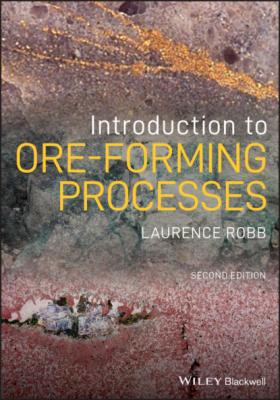Introduction to Ore-Forming Processes. Laurence Robb
Читать онлайн.| Название | Introduction to Ore-Forming Processes |
|---|---|
| Автор произведения | Laurence Robb |
| Жанр | География |
| Серия | |
| Издательство | География |
| Год выпуска | 0 |
| isbn | 9781119232384 |
Metals
1 Gold – Au
2 Silver – Ag
3 Platinum – Pt
4 Palladium – Pd
5 Copper – Cu
Non‐metals
1 Sulfur – S
2 Diamond – C
3 Graphite – C
Halides
The halide mineral group comprises compounds made up by ionic bonding. Minerals such as halite and sylvite are cubic, have simple chemical formulae, and are highly soluble in water. Halides sometimes form as ore minerals, such as chlorargyrite and atacamite.
1 Halite – NaCl
2 Sylvite – KCl
3 Chlorargyrite – AgCl
4 Fluorite – CaF2
5 Atacamite – Cu2Cl(OH)3
Sulfides and Sulfosalts
This is a large group of minerals in which bonding is both ionic and covalent in character. The sulfide group has the general formula AMXP, where X is typically S but can be As, Sb, Te, Bi, or Se, and A is one or more of the metals. The sulfosalts, which are less common than sulfides, have the general formula AMBNXP, where A is usually Ag, Cu, or Pb, B is commonly As, Sb, or Bi, and X is S. The sulfide and sulfosalt minerals are generally opaque, dense, and have a metallic to sub‐metallic luster.
Sulfides
1 Chalcocite – Cu2S
2 Bornite – Cu5FeS4
3 Galena – PbS
4 Sphalerite – ZnS
5 Chalcopyrite – CuFeS2
6 Pyrrhotite – Fe1–xS
7 Pentlandite – (Fe,Ni)9S8
8 Millerite – NiS
9 Covellite – CuS
10 Cinnabar – HgS
11 Skutterudite – (Co,Ni)As3
12 Sperrylite – PtAs2
13 Braggite/cooperite – (Pt,Pd,Ni)S
14 Moncheite – (Pt,Pd)(Te,Bi)2
15 Laurite – RuS2
16 Cobaltite – CoAsS
17 Gersdorffite – NiAsS
18 Loellingite – FeAs2
19 Arsenopyrite – FeAsS
20 Molybdenite – MoS2
21 Realgar – AsS
22 Orpiment – As2S3
23 Stibnite – Sb2S3
24 Bismuthinite – Bi2S3
25 Argentite – Ag2S
26 Calaverite – AuTe2
27 Pyrite – FeS2
Sulfosalts
1 Tetrahedrite – (Cu,Ag)12Sb4S13
2 Tennantite – (Cu,Ag)12As4S13
3 Enargite – Cu3AsS4
Oxides and Hydroxides
This group of minerals is variable in its properties but is characterized by one or more metals in combination with oxygen or a hydroxyl group. The oxides and hydroxides typically exhibit ionic bonding. The oxide minerals can be hard, dense, and refractory in nature (magnetite, cassiterite) but can also be softer and less dense, forming as products of hydrothermal alteration and weathering (hematite, anatase, pyrolusite). Hydroxides, such as goethite and gibbsite, are typically the products of extreme weathering and alteration.
Oxides
1 Cuprite – Cu2O
2 Hematite – Fe2O3
3 Ilmenite – FeTiO3
4 Hercynite – FeAl2O4
5 Gahnite – ZnAl2O4
6 Magnetite – Fe3O4
7 Chromite – FeCr2O4
8 Rutile – TiO2
9 Anatase – TiO2
10 Pyrolusite – MnO2
11 Cassiterite – SnO2
12 Uraninite – UO2
13 Thorianite – ThO2
14 Columbite‐tantalite – (Fe,Mn)(Nb,Ta)2O6
Hydroxides (or Oxyhydroxides)
1 Goethite – FeO(OH)
2 Gibbsite – Al(OH)3
3 Boehmite – AlO(OH)
4 Manganite – MnO(OH)
Oxysalts
The carbonate group of minerals form when anionic carbonate groups
Carbonates
1 Calcite – CaCO3
2 Dolomite – CaMg(CO3)2
3 Ankerite – CaFe(CO3)2
4 Siderite – FeCO3
5 Rhodochrosite – MnCO3
6 Smithsonite – ZnCO3
7 Cerussite – PbCO3
8 Azurite – Cu3(OH)2(CO3)2
9 Malachite – Cu2(OH)2CO3
Tungstates
1 Scheelite – CaWO4
2 Wolframite – (Fe,Mn)WO4
Sulfates
1 Baryte(s) – BaSO4
2 Anhydrite – CaSO4
3 Alunite – KAl3(OH)6(SO4)2
4 Gypsum – CaSO4·2H2O
5 Epsomite – MgSO4·7H2O
Phosphates
1 Xenotime – YPO4
2 Monazite – (Ce,La,Th)PO4
3 Apatite – Ca5(PO4)3(F,Cl,OH)
Vanadates
